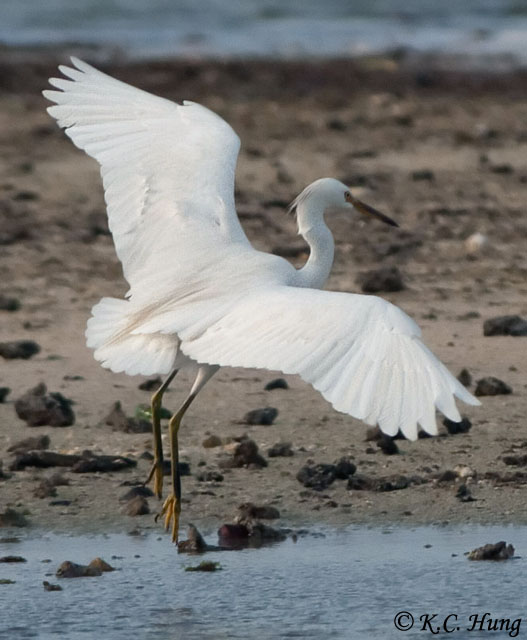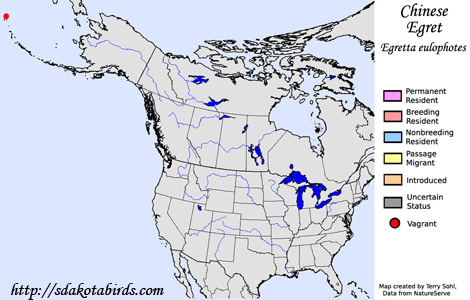| Length: 26 - 28 inches | Wingspan: 45 inches | Seasonality: Non-resident in South Dakota |
| ID Keys: White plumage, yellow bill, shaggy white plumes on nape, dark legs with yellow feet | ||
 The
Chinese Egret is a large egret species of southeast Asia, primarily found in
Korea, China, and Russia. In North America, they are known from only a
single sighting, a bird that was identified on Attu Island at the end of the
Aleutian Island chain. Given the general lack of long-distance
movements of the species, coupled with the fact that they are in severe
decline in their native range due to habitat loss, the Attu sighting may
prove to be a one-time event. Global populations of the species may only
number from 4,000 to 15,000 (BirdLife
International estimate).
The
Chinese Egret is a large egret species of southeast Asia, primarily found in
Korea, China, and Russia. In North America, they are known from only a
single sighting, a bird that was identified on Attu Island at the end of the
Aleutian Island chain. Given the general lack of long-distance
movements of the species, coupled with the fact that they are in severe
decline in their native range due to habitat loss, the Attu sighting may
prove to be a one-time event. Global populations of the species may only
number from 4,000 to 15,000 (BirdLife
International estimate).
Habitat: Found on offshore islands during the breeding season. At other times, found in tidal estuaries and mudflats along the coast.
Diet: Feeds on fish, crustaceans, marine worms, and other small creatures found in the tidal zone.
Behavior: Foraging of the Chinese Egret often consists of walking rapidly along a mudflat or in the shallows, using a thrust of their neck and bill to snap up prey when spotted. Therapid walking and movement may also flush fish and other creatures, allowing the Chinese Egret to spot them easier.
Nesting: The nest is a platform of sticks and branches built in a tree. The female lays between 3 and 5 eggs, and both parents help to incubate them. When the eggs hatch, both parents help to feed them. The young typically stay in the nest for about one month.
Song: Usually silent, but they do have a croaking call that is sometimes given when disturbed.
Migration: Migratory, with non-breeding birds moving southward into Indonesia as well as eastward to Japan.
Interactive eBird Map: Click for access to an interactive eBird map of Chinese Egret sightings
Similar Species: Similar in general appearance to the North American white egrets (Great Egret, Snowy Egret, Cattle Egret).
Conservation Status: Populations of Chinese Egret have been in severe decline, as their natural habitats have been destroyed. The IUCN lists the Chinese Egret as a "Vulnerable" species.
Further Information: 1) BirdLife International - Chinese Egret
2) ARKIVE.org - Chinese Egret
3) Whatbird.org - Chinese Egret
Photo Information: Photo taken by K.C. Hung - Photo licensed under Creative Commons Attribution NonCommercial ShareAlike 2.0 Generic License.
| Click below for a higher-resolution map |
 |
| South Dakota Status: Non-resident in South Dakota |
Additional Chinese Egret Photos (coming soon!!)
